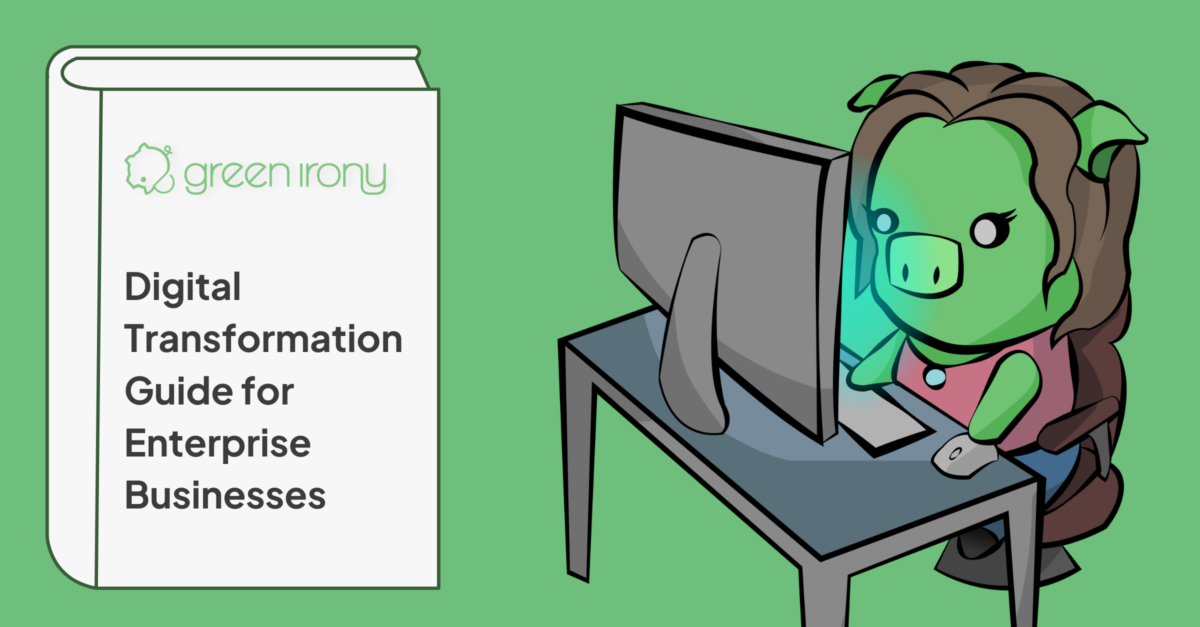Companies focus on digital transformation to enable new product offerings and customer experiences through technology. This is being done through new technology, and/or upgrades to current technology, but the key with digital transformation is that these changes are happening at a massive rate. More businesses are relying on technology to solve their problems without assessing their business roadmap and processes to begin with.
Digital transformation, which has been seen more over the last decade, was originally in reference to paper-based processes and transitioning those to digital processes. Since more companies have invested in technology, there will continue to be investments made in new capabilities that weren’t originally available to the average customer or employee.
What Digital Transformation Is for a Company Today
The need for enterprise-wide digital transformation originates from three major areas:
- To improve the customer experience.
Most companies value this as a high priority and are fully aware of the issues and causes.
- To improve the experience of your employees.
Unfortunately, not many companies value this as high as they should be, and may not be aware it is an issue. What most companies don’t realize is that improving the experience of your users can also improve the experience for your customers. - To grow revenue.
This is typically the biggest driver of them all.
What Drives Digital Transformation in an Enterprise
As mentioned: Revenue growth is the main driver for many enterprises. By leveraging digital transformation, businesses can tap into new markets, new channels, and create new product offerings. These are all things that can improve the customer and user experience, but also give you more revenue growth.
Customer experience, employee experience, and revenue growth all build on top of each other. And as an added bonus, digital transformation can enable operational efficiency, which means being able to look at your operational costs, and how you leverage technology to accelerate business processes and offset any labor costs.
How Important Is Digital Transformation for Your Business?
Digital transformation is typically seen as a marketing buzzword or an umbrella term that is just in reference to technology. However, that’s far from the truth. If it was simple, businesses would be thriving across the globe.
What also falls under the digital transformation umbrella, and is a critical factor in truly leveraging the technology you have, is change management. IT doesn’t just solve the problem. A business must be willing to change its own processes to make for a successful shift into the new technology.
The most important part of digital transformation is how you leverage that technology and adopt new technology within the entire organization. The ability to succeed in digital transformation, and continue to grow as an organization, is dependent on business outcomes from customer and user satisfaction.
In order for change management to succeed, businesses must be willing to check egos at the door, innovate, and take the risk to move forward in order to survive.
Benefits of a Good Digital Transformation Strategy
Customer Experience Improvements
If your business acquires a new piece of technology, you have to understand how it will affect the customer base in the present. You have to then integrate new technology into their lives, which takes a lot of time and planning upfront. You must meet your business objectives, but any digital transformation efforts must be thought of with the customer in mind.
For example, if the number one thing that you’re trying to do is give your customers a new way to interface with your employees, like a chatbot service, then that should be at the forefront of your digital transformation roadmap.
You should be solving for what is going to cause your customers the least amount of friction. For example, with a chatbot service, it’s imperative to keep contextual awareness front and center by integrating back-office data to the active chat so the customer doesn’t have to dig up details.
Employee Experience Improvements
The employee experience can be forgotten because the focus is completely on the customer. Businesses focus on them because they’re the ones that are ultimately paying the bills, but if you take a look at how your frontline support is better able to serve your customers a better experience, your employees are able to keep them.
If you’re looking at digital transformation to help with the employee experience, you should be focused on how you can give them access to information without having to go into multiple systems. The majority of enterprises are going to be run over with hundreds of applications.
Every time you have an employee that has to swivel between these different applications to serve one customer interaction, the more the customer suffers, and the more the employee suffers.
Improved Business Intelligence Based on Real-time Data
Real-time data is a big problem for many companies that are actively pursuing digital transformation, and it stems from being unable to integrate their data properly. A key to measuring the success of your digital transformation efforts is to ensure that you focus on making your data not only available to the user but to the business users analyzing the data as well.
Whether you have a BI tool today or not, having a strategy for storing and processing large amounts of data through a data lake or other means is a necessity to ensure your data integration is feeding those systems with accurate and timely data.
Either way, by having data integration and workflows on your side, digital transformation can inform decision-making instead of just guessing how to proceed and hoping for the best possible outcome.
Identify Barriers to Improve Profitability
This new piece of technology will feed into your business processes and feed into the overall health of your business. So how do you actually de-risk that technology investment you just made?
It’s more about making sure that it’s part of the conversation as you go on that digital transformational journey and making sure that it aligns with the business objectives of your organization. And that’s where your digital transformation strategy comes into play.
Building a Digital Transformation Strategy
What do you need to know before beginning your digital transformation journey?
- You’ll need to identify your vision or ideal technology scenario.
All digital transformation requires the integration of data either into a new or an existing system. Or, there are going to be multiple new systems that need to enable a new employee or customer experience, and those systems must communicate with one another. - It doesn’t have to happen all at once…
You can start a foundation of integration between these systems without having to roadmap your entire digital transformational journey. You have your vision and you can start to build that foundational layer of communication between applications. - …But you don’t have to wait months or years to get started.
Perfection is not the goal. You can still be on the path to achieving digital transformation without having all the answers. By defining your user experiences, you can then build on the foundation with an API or integration strategy that is ultimately going to support those new experiences and scale as you continue to learn from your journey.
Digital Technologies You Need for a Successful Digital Transformation
A CRM, Like Salesforce, As Your Single Source of Truth
Salesforce is not a CRM. It’s way more than that. Salesforce is going to give you the most benefit, especially when you’re looking at expanding your customer experiences, and most notably your employee experiences.
Salesforce can give the information you need in a highly consumable way, especially when your employees interact with customers. Whether they’re in the sales process trying to understand the interactions that person has had across different marketing channels or across different data sources, that gives you a holistic view of your sales process all the way to your service side of customer orders, purchases, etc.
And now when an employee communicates with that customer, they already know exactly what they need to know. The employee is able to do their job better and help the customer better. But, (isn’t there always a but?) that requires having information integrated into Salesforce.
As mentioned, technology isn’t a magic solution, but it’s how you leverage it that provides the solution you need. Your data will either be something that is integrated natively into Salesforce, or it is something that is integrated during the experience.
An Enterprise API Solution, Like MuleSoft, for Scalability
Digital transformation’s backbone is the integration of information, and whether that’s from offline processes to real-time interactions, iPaaS can help govern the outcomes you’re looking to achieve. It’s also about exposing new capabilities, and expanding on those capabilities.
A single source of truth for your business users is always top of mind, but what about the single source of truth for the IT department and the data available for all applications? This is where MuleSoft fits in. Many enterprises use digital transformation as the catalyst to take on an API Strategy that will start to decompose their systems into a digital business through an iPaaS.
So if you’ve invested in an iPaaS solution, like MuleSoft, you’ve now created a space for you to continue to evolve that integration between those systems and add on new tools without having a large impact on the effort that has already been done.
You’re not looking to increase custom development. You need to accelerate that development and the integration between systems without having to bear the burden of writing a ton of custom code.
API Security Tools, Like Noname Security, for Preventing Cyber Attacks
Data breaches and cyberattacks are not news. We hear about them more than we would like, and it’s usually a problem that can cost millions of dollars. When you are going through the data integration process and you are opening up these systems, you are now creating a larger digital footprint, and therefore your attack vectors are growing.
As you build this connectivity between systems, it must meet the OWASP Top 10 Vulnerabilities, and be continuously monitored and managed by a platform, like Noname Security. You can’t expect humans to do this work, and you need a platform that can offset that cost and provide a better layer of protection that they can manage.
If you have an increasingly growing need for integrating other systems, it’s imperative to have a watchful eye in an automated fashion so systems like Noname Security protect your business.
The Role of Automation in Digital Transformation
In digital transformation, automation plays two key roles:
- Looking at the manual tasks that exist today.
The manual aspect of moving data from one system to another creates bottlenecks. If you are spending time updating account or customer information, you could look to automation to actually do that job for you. By doing so, you can avoid stalling your digital transformation journey due to a manual process that impedes progress toward a process that has already been transformed. - Unlocking business processes that were previously not capable.
Let’s take, for example, the paper-based business model. If you’re not able to meet their customer digitally and you have a paper process as the preferred entry point, you could look at how to automate those forms that the customers are filling out. You have now digitally transformed this entry and kept your customers satisfied while optimizing your own employee experience.
These automations can be created as band-aids until you can transform that part of the business later in your roadmap or they can become the cornerstone of that transformation. The important takeaway here is that automation gives you that option and unsticks previously sticky digital transformation hurdles.
Automation can solve many things:
- Unnecessary time spent on manual data entry
- Complex custom integrations
- Closed platforms and siloed tech capabilities
- Operational inefficiencies affecting your bottom line
However, with automation at the forefront of a lot of business roadmaps in a shaky economy, many leaders don’t want to take the risk. There’s a common misconception that it takes businesses more time to start automating than to stay with the status quo.
Our automation workshop helps businesses confidently meet short- and long-term goals.
How to Speed Up Digital Transformation Initiatives in Your Company
Prioritize Agile Digital Transformation Process Without Compromising Quality
Digital transformation shouldn’t follow the Big Bang approach. It must be broken down into the biggest outcome you can get with enabled digital experiences that produce a minimum amount of risk.
Make sure you use the capabilities that are in the software you have invested in. During procurement, the users and business should be aligned on how they can transform to use the capabilities that are offered and avoid endless customizations before ever going live with the new tool.
And that’s not the end of your digital transformation journey. That’s just a milestone within that journey that you’ll continue to iterate from.
Can my business complete our digital transformation journey successfully on our own without outside help?
I would say no, and it’s not because you don’t have capable people or don’t have the will to do it. It comes down to two things:
- You’re already running a business and now you’re looking to transform it.
That’s like changing the tires while the car is still running. It takes time, skill, and work, in addition to what you and your teams are already accomplishing. That’s where a consultancy comes in, to help expand your bench and leverage the right pieces of technology so you aren’t stuck in the day-to-day.
You are already running at full speed, you don’t want to settle for going backward and restarting to crawl-walk-run. These initiatives should get you to run faster and more efficiently.
- You’re dealing with pieces of technology that you haven’t had to deal with before.
And it makes a lot more sense to bring on experts in that technology to guide you in the best way to use it and solve these problems instead of figuring it out on your own.
Let’s face it, consultants are always right…or I mean the customer is always right. But why not both? You need to have the right partner to challenge you based on the experiences they have with the technology while also being willing to listen to what you WANT. That will build trust that leads to a successful digital transformation journey.
Selecting a Digital Transformation Company
Step One: find a service provider with expertise in enterprise technology transformation and successful digital transformation consulting services.
You know your business. Trust us to build the strategy built on sound technology principles and extensive digital transformation experience. We pride ourselves on seeing the big picture of your business so we can assess where you are at, build a strategic roadmap, properly architect the full enterprise solution, and engineer the solution leveraging all capabilities of your software investments to achieve your transformation goals.
Get your Free Digital Assessment here.
Also, stay tuned for our resource: Steps to Achieve Digital Transformation.






